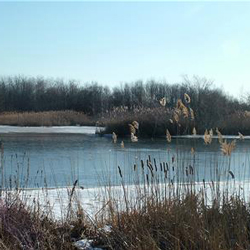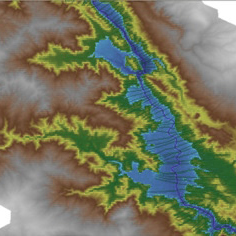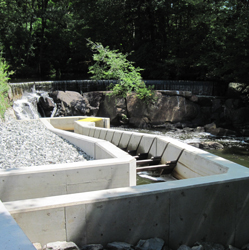Program Overview
Mission and Authorization
A significant portion of EMRRP research is focused on improving our fundamental understanding of the physical and biological processes and interactions within ecosystems, developing modeling tools to enable rapid assessment of the impacts or benefits associated with different management strategies or restoration efforts, developing tools and guidelines informing alternatives comparisons and decision-making, and developing training to enable the broad application of the tools developed under the program.
As our fundamental understanding evolves, so do our environmental restoration and management practices. EMRRP is a crucible for cutting edge environmental practice and innovative problem solving.
(read more) or see the Statments of Need (CAC).
Focus Areas

photo by Andrew Stamer
Multi-objective Restoration
Maximum benefit from ecosystem restoration projects is achieved when approached from a holistic perspective that considers the impacts and opportunities of the restoration effort within the larger landscape. An aquatic restoration project may provide social and recreational benefits to the surrounding community with only minor modifications to the project design. Reservoirs designed and constructed chiefly for flood control and water storage, can also provide environmental benefits when water quality and environmental requirements are integrated into the operational rules for the reservoir. Removal of aging dams can achieve both flood risk reduction and environmental benefit through reestablishment of fish passage and natural sediment transport. By combining the mission areas and resources of multiple agencies in collaborative restoration projects, multiple objectives can be satisfied, yielding greater benefits overall and making best use of environmental resources. EMRRP R&D supports such the goals of multi-objective restoration through development of frameworks and modeling tools informing alternatives comparisons and project optimization, and facilitating effective communication between multiple stakeholders, in addition to advancing the science of ecological restoration itself.
Integrity & Sustainability
Changing conditions, increased frequency of extreme events and overall variability in climatological variables will continue to challenge both inland and coastal areas. To ensure the continuing ecological integrity and resilience of our nation’s aquatic resources, EMRRP is focused on developing new science and engineering tools informing impacts analysis of weather-related hazards and sea level rise, among other factors, and to explicitly integrate ecological variability concepts into restoration projects. For example, investigations into multi-dimensional modeling and ecological thresholds, characterization of interactions between ecosystem components such as riparian vegetative communities and flood flows, developing methods to improve habitat connectivity, and incorporating adaptive management concepts into restoration research and implementation, can increase the capability of these systems to absorb perturbations and changing regimes.
Inland Resource Management
With specific focus on inland riverine, wetland and lake or reservoir environments, the EMRRP is pursuing research to increase resilience and reliability of inland aquatic ecosystem restoration. Increasing extreme precipitation events in recent years, combined with urbanization, impoundments and stormwater management issues make freshwater environments especially vulnerable. New methods are needed to project anticipated impacts of episodic events and to assess the rate and degree of long term changes due to urbanization and exposure to natural hazards. Modeling tools are needed to inform changes to the way in which reservoirs are managed that address not only water quantity, but also quality and minimum required flows, in order to protect sensitive downstream environmental resources. There is great opportunity to couple inland resource management efforts with navigation and flood risk management efforts to reduce overall uncertainty and more effectively account for inevitable climatological volatility. Planning and modeling tools enabling assessment of the cumulative benefit of discrete restoration projects on a landscape and watershed level are needed to inform future design of restoration with specific cumulative benefit goals and greater assurance of long-term ecological stability of inland aquatic resources and habitats.
Coastal Resilience & Function
Coastal and estuarine aquatic and wetland environments provide critical ecological habitat and services, while also contributing to coastal resilience, providing protection from storms through wave attenuation and storm surge reduction. The effects of increasing extreme storm events, coupled with sea level rise and isolation from natural sustaining sediment sources endanger these vital areas, yet guidance pertaining to appropriate management and restoration is limited and, in some cases, contradictory. Research is needed to better understand the systems interactions in coastal environments, and the causative mechanisms of physical and functional degradation, to enable identification of reliable indicators of condition and trends and inform appropriate management and restoration efforts. Several multi-agency projects are currently underway - demonstrating innovative marsh restoration methods - such as thin layer placement of dredged material – and are providing data needed to develop more comprehensive guidelines for assessment, management and restoration of coastal areas.
T&E and Invasive Species Management
Management of opportunistic species is a key component of successful ecosystem restoration, where desired vegetation may be slower to establish than other species, which may include invasives. Similarly, the potential impacts of land management and ecosystem restoration efforts on threatened and endangered (T&E) species must also be considered. As an example, removal of established invasive vegetation – while theoretically desirable from the standpoint of restoring original conditions - could also negatively impact T&E species who are dependent upon that vegetation as habitat. Clearly, in restoration planning, design and implementation, both invasive species management and T&E species impacts need to be carefully considered in a holistic approach. Effective characterization of ecological communities, protection and preservation of species of concern, increasing habitats for native species and development of innovative invasive species control are critical in the face of the increasing spread of exotics and pressures on native communities nationwide due to urbanization and exposure to natural hazards, to name just too stressors. Advancing the Corps’ capabilities to detect, monitor, and evaluate key species that significantly influence restoration activities, with design and management recommendations to restore the range and abundance of threatened and endangered species while limiting the expansion of exotic invasive or nuisance species, are of particular interest to the EMRRP program.
Modeling & Decision Making Tools
Uniquely positioned to provide SMART planning support, EMRRP is directing research toward improving current state-of-the-science assessment approaches, underlying model assumptions and relations, and data requirements - integrating impacts, and meaningful metrics to permit biologically-effective decisions. Particular emphasis on dynamic and sensitive models applicable across multiple scales and capable of predicting future conditions is needed to give Corps decision-makers robust assessment tools that incorporate modern ecosystem principles that are easy to apply, offer significant user flexibility to meet individual project requirements, and provide relevant quantifiable output. These tools can be delivered through field user-focused technical guidance documents, web-based decision support systems, webinars, classroom and internet based training, and product technical support, as required.
Ecological Infrastructure
Assessing the role, function and design of Natural and Nature-based Features (NNBF) in ecological restoration within an “integrated” multi-objective and multi-business line context is an important applied emphasis for the EMRRP. Research and development of technologies for structural and non-structural ecosystem restoration measures that can serve Environment, Navigation and Flood Risk Management objectives takes advantage of the combined interest in safe, effective and efficient restoration projects. Design and implementation methods that make creative use of energy environments, combine natural, native and fabricated materials and that directly incorporate ecosystem processes, can dramatically improve functional success of aquatic ecosystem restoration in many environments, adding secondary and tertiary ecological benefits while reducing or eliminating negative impacts.
About our Researchers and Resources
The EMRRP research mission is executed by world class researchers – known in our organization as principal investigators, or PI’s - possessing a broad array of technical expertise and experience in the Environmental and Engineering sciences. The EMRRP program is administered within the Environmental Laboratory at ERDC but draws upon resources and personnel from all seven of the Corps’ research labs within ERDC, in addition to USACE Division and District personnel. Researchers at ERDC have available to them specialized facilities and equipment necessary for advanced, high capacity computing, software and model development, laboratory testing and field studies.
This breadth and depth of capabilities and resources allows us to assemble teams with the necessary expertise to lead or support projects requiring significant technical judgement and innovation.
While the core of the EMRRP research portfolio is developed to address research needs identified by USACE field offices, the role of our PI’s is not limited to research. PI’s also participate on USACE Project Development Teams (PDT’s), provide support to other federal agencies as subject matter experts, and collaborate on joint research efforts. In certain cases, PI’s are also able to support or collaborate with private sector organizations and academic institutions, under the provisions of vehicles such as Cooperative Research and Development Agreements (CRDAs) and Testing Agreements.
EMRRP research projects are usually led or mentored by Ph.D. level engineers and scientists with extensive technical expertise in their fields, who are experienced in planning and executing research, and who possess a solid understanding of the practical context and application of the intended research products. Much of the EMRRP’s focus is on developing actionable tools and frameworks/guidelines informing planning, design and execution of ecosystem restoration projects. In particular, the EMRRP program supports USACE project planners working under the Corp’s highly structured planning process – known as SMART planning – which involves completion of a predefined set of planning milestones within a specified time frame. This can be very challenging, and requires a highly specialized set of tools.






